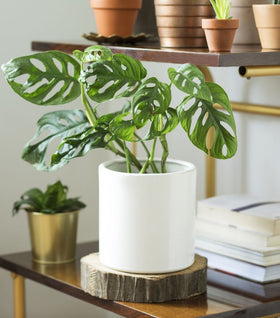Monsteras for Sale Online
Native to Central America, Monstera is a species of evergreen tropical shrubs and vines. Known for their natural leaf-holes called fenestrations, they are theorized to have this structure due to their rainforest roots. These house plants rarely flower, however they can produce edible fruit indoors.
Monstera is quickly becoming one of the most popular and trendy house plants to own. Their air-purifying abilities and strong characteristics make them perfect in any home.
Types of Monstera Plants
Monstera deliciosa
Monstera Deliciosa has been of the most sought-after houseplants for years. It has large, heart-shaped split leaves that can reach up to a foot long and wide. This interior plant's leaves bring a tropical feel to any indoor space. As your plant ages, its holes and splits develop, making it a beautiful plant to watch grow.
Monstera adansonii
Monstera adansonii, the Swiss Cheese plant, gets its perfect description for its unique foliage. Each leaf has oval-shaped holes that have been theorized to allow sun and water through to the lower leaves in tropical environments and help the leaves stand up to forceful winds.
Mini Monstera
Rhaphidophora tetrasperma is a rare mini cousin of the Split Leaf Monstera. Its vibrant green split-leaf foliage freshens any indoor corner or office with its compact size. This houseplant has a climbing growth habit and vines beautifully when placed near railings, bookcases, or shelves.
Growing Monstera Plants Indoors
Monstera is a very easy houseplant to take care of and is recommended for any first-time plant owner. It is fairly low maintenance, and as long as you put it in a good location and pot it in the proper soil, your plant will be happy and thrive for years to come.
Light
Monstera plants thrive in bright to medium indirect light. Placing them near a window that had direct sunlight could cause their leaves to have grey or black spots. However, they can be acclimated to withstand direct light. Slowly introduce your houseplant to direct light by moving it closer to the desired location each day. The slow process will allow your plant to take the time it needs to adjust to its new habit.
Water
Monstera plants do not need a strict watering routine. The best rule of thumb is to water every 1 to 2 weeks, allowing the soil to dry out in between. However, you should expect to water more frequently in brighter light versus lower light. Also, Monsteras benefit greatly from filtered water or leaving water out overnight before using.
Soil
Any good quality potting soil with peat moss and is well-draining works with Monstera. These houseplants thrive in dense, nutrient-rich soil, but do not do well in potting soils with bark or compost. Make sure you pot them in a container with drainage holes. If your container does not have drainage holes, make a few a the bottom to avoid the risk of root rot.
Humidity
Your houseplant will grow fine in normal room humidity, however, they prefer more humid conditions. Try purchasing a mini humidifier and placing it next to your houseplants. Doing so will help with any extra humidity they are missing out on. As long as your interior temperatures do not drop below 60 degrees your plant will grow beautifully.
Benefits of Monstera as a Houseplant
Monstera plants are full of wonderful benefits. They are known to be an air-purifying plant that is useful in humidifying air conditions. Some Monsteras produce fruit full of Vitamin C, proteins, Vitamin B, calcium, and phosphorous. However, it is important to be extremely careful with their fruits as they can be poisonous if they do not completely ripen. They are also known for being a cure for insect or snake bites.
Their benefits are vast but it is important to not forget that these houseplants, when consumed in high doses, will result in diarrhea and stomach cramps. It is best to keep this plant out of reach of any pets or children.
How to Propagate a Monstera Plant
Once your Monstera is fairly mature and healthy, you can begin to propagate it and grow your own Monstera. Firstly, find a pair of sharp shears or a knife and cut directly below a node or aerial root. Be sure to cut each leaf and node into individual segments on either side of the areal root or node. Next, pull off any old sheathing from the stems to prevent them from rotting when submerged in water.
Before submerging your cuttings into a vessel of your choosing, give a few minutes for them to dry out and "heal". After they have dried out, carefully roll it up just so it fits comfortably at the bottom of your container. Finally, pour water until the roots and ends are completely submerged. Place your growing plant in bright, indirect light, and remember to change the water every 3 to 5 days. You should begin to see developing roots in about 2 to 3 weeks!




